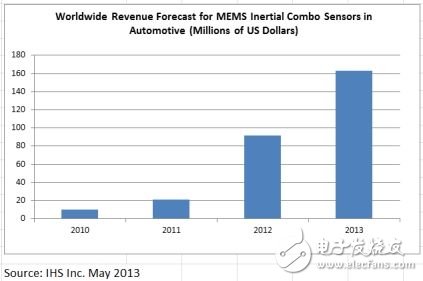Market research company IHS iSuppli pointed out that, thanks to the rapid popularization of automotive safety regulations and the application of automotive safety systems in recent years, the market for composite MEMS inertial sensors for automotive applications is expected to reach a scale of US $ 163 million in 2013, a substantial growth 77% ,.
IHS said that as more and more cars introduce safety systems, the use of these types of sensors in cars is also increasing rapidly. Last year, this type of sensor market grew by approximately 338%, reaching a market size of US $ 92 million, a significant increase from the US $ 10 million in 2011.
A compound inertial sensor is a multi-sensor element that integrates an accelerometer and a gyroscope in a single package to provide inertial input for an electronic stability control system (ESC) in a car to avoid or reduce slippage.
"In North America, Europe, and other places where regulations are mature, such as Australia, Japan, Canada, and South Korea, it is mandatory for cars to adopt the ESC system," noted Richard Dixon, principal analyst of MEMS and sensors at IHS. However, "in some There are still huge business opportunities in the field of development. For example, China provides a larger market, which will obviously affect the penetration rate of ESC in the world. However, from another perspective, it will also compound the overall vehicle. Sensor brings huge growth driving force and kinetic energy. "

IHS stated that the main suppliers of automotive inertial sensors include Bosch (Germany) and Murata (VTI); there are also two potential manufacturers-Panasonic (Japan) and headquarters ADI in Massachusetts, USA, also needs to develop similar solutions to successfully grasp this market opportunity.
IHS said that the current ESC system for automobiles includes three architectures: the first is to be placed on the circuit board like an independent ESC engine control unit (ECU). The second architecture is connected to the brake modulator to save wiring. The third type of ESC system is configured together with the automotive airbag ECU.
IHS said that in these three different configurations, the current trend is to adopt the method of placing the ESC system in the airbag ECU to achieve a smaller footprint and higher efficiency, especially in the position of the ECU in the car. Space is very limited, so it is more beneficial to adopt a space-reducing architecture.
Compared to stand-alone sensor configurations, sensors manufactured specifically for the combined sensor ESC system architecture (such as products developed by ConTInentail) can reduce space by up to five times, IHS emphasizes. Non-combined solutions also exist in the form of separate installation on the circuit board. IHS said that deploying sensors in a compound way can not only reduce the cost of packaging, but because the two sensors in the compound package can share the same ASIC, they can use expensive semiconductor components as much as possible.
One of the most important issues in the ESC system is cost. IHS explained that this is because ESC was considered as an optional equipment in the car; however, since the government forced the ESC system, it has now become a car like a seat belt The necessary accessories.
Therefore, in the entire supply chain and pricing structure, automotive composite sensors have experienced huge pressure from car manufacturers to downstream. The first-tier manufacturers pass this pressure on to suppliers, demanding to accelerate the provision of high-efficiency compound sensor solutions for ESC system inertial sensors.
IHS emphasized that under this pressure, some first-line players believe that in the future, only traditional business will adopt the traditional configuration scheme of PCB with independent sensors. Therefore, all new car models in the future will use composite sensor solutions.
SUPER BRIGHT CREE-3W LED TECHNOLOGY (165 feet beam) - wide variety of white & red light modes + 45° tiltable body makes this headlight brightest and most versatile in its class. SOS and strobe mode will keep you safe in any situation.
WATERPROOF AND DURABLE – why equip yourself with anything but the best and most reliable headlamp? MX20 is built to last. It is rated to IPX5, which means it is protected against splashing or spraying water from any angle.
EXTENDED BATTERY LIFE – More light while using less energy? Sure! Foxelli head flashlight offers up to 45 hours of run-time. 3x AAA ENERGIZER batteries are included, so you can start using your brand-new Led Headlamp right out of the box.
LIGHTWEIGHT AND COMFORTABLE – you won't even notice wearing it. Weighing only 3.2 ounces (with batteries) with easily adjustable, ergonomically designed elastic headband makes this light perfect for long distance runners looking for a comfortable fit.
SUPER LONG BATTERY LIFE – by using leading CREE – 3W technology MX20 provides more light with less power used, resulting in up to 45 hours of run-time. 3 AAA ENERGIZER batteries included. Each head torch has been tested for quality.
Led Headlamp
Super Bright Headlamp,Bright Headlamp,Rechargeable Led Headlight,Bright Led Headlight
Ningbo Wason Lighting Technology Co.,Ltd , https://www.wasonlight.com